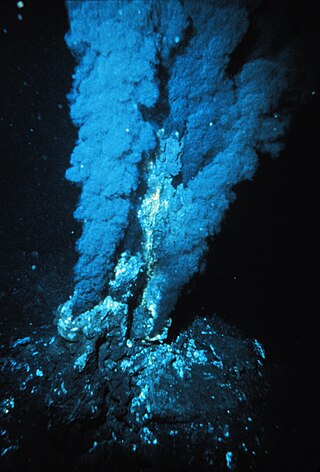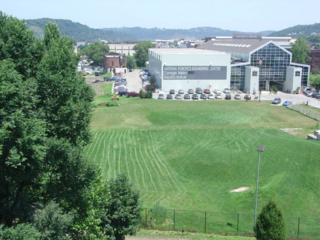
The Ames Research Center (ARC), also known as NASA Ames, is a major NASA research center at Moffett Federal Airfield in California's Silicon Valley. It was founded in 1939 as the second National Advisory Committee for Aeronautics (NACA) laboratory. That agency was dissolved and its assets and personnel transferred to the newly created National Aeronautics and Space Administration (NASA) on October 1, 1958. NASA Ames is named in honor of Joseph Sweetman Ames, a physicist and one of the founding members of NACA. At last estimate NASA Ames had over US$3 billion in capital equipment, 2,300 research personnel and a US$860 million annual budget.

The Nomad rover is an uncrewed vehicle designed as a test for such a vehicle to ride on other planets.

The Mars Polar Lander, also known as the Mars Surveyor '98 Lander, was a 290-kilogram robotic spacecraft lander launched by NASA on January 3, 1999, to study the soil and climate of Planum Australe, a region near the south pole on Mars. It formed part of the Mars Surveyor '98 mission. On December 3, 1999, however, after the descent phase was expected to be complete, the lander failed to reestablish communication with Earth. A post-mortem analysis determined the most likely cause of the mishap was premature termination of the engine firing prior to the lander touching the surface, causing it to strike the planet at a high velocity.

Phoenix was an uncrewed space probe that landed on the surface of Mars on May 25, 2008, and operated until November 2, 2008. Phoenix was operational on Mars for 157 sols. Its instruments were used to assess the local habitability and to research the history of water on Mars. The mission was part of the Mars Scout Program; its total cost was $420 million, including the cost of launch.
Zoë is a solar-powered autonomous robot with sensors able to detect microorganisms and map the distribution of life in the Atacama Desert of northern Chile, duplicating tasks that could be used in future exploration of Mars. Zoë is equipped with tools and sensors to search for direct evidence of life beneath the surface of the ground. Zoë significantly aids in research needed to study Mars because it acts as a mobile observer and analyzer of any signs of life in a given location. She collects primary data which will help in understanding conditions present on Mars. This project will verify reliability of autonomous, mobile, and scientifically made robots.

The NASA Institute for Advanced Concepts (NIAC) is a NASA program for development of far reaching, long term advanced concepts by "creating breakthroughs, radically better or entirely new aerospace concepts". The program operated under the name NASA Institute for Advanced Concepts from 1998 until 2007, and was reestablished in 2011 under the name NASA Innovative Advanced Concepts and continues to the present. The NIAC program funds work on revolutionary aeronautics and space concepts that can dramatically impact how NASA develops and conducts its missions.

William L. "Red" Whittaker is an American roboticist and research professor of robotics at Carnegie Mellon University. He led Tartan Racing to its first-place victory in the DARPA Grand Challenge (2007) Urban Challenge and brought Carnegie Mellon University the two million dollar prize. Previously, Whittaker also competed in the DARPA Grand Challenge, placing second and third place simultaneously in the Grand Challenge Races.

The Deep Phreatic Thermal Explorer (DEPTHX) is an autonomous underwater vehicle designed and built by Stone Aerospace, an aerospace engineering firm based in Austin, Texas. It was designed to autonomously explore and map underwater sinkholes in northern Mexico, as well as collect water and wall core samples. This could be achieved via an autonomous form of navigation known as A-Navigation. The DEPTHX vehicle was the first of three vehicles to be built by Stone Aerospace which were funded by NASA with the goal of developing technology that can explore the oceans of Jupiter's moon Europa to look for extraterrestrial life.
Almost Human: Making Robots Think is a book written by Lee Gutkind founder of Creative Nonfiction. Gutkind spent six years as a "fly on the wall" researcher at the Robotics Institute at Carnegie-Mellon University in Pittsburgh. He observed scientists and students working to design, build, and test robots so advanced that they will one day be able to work alongside or, in some cases, even replace humans. Almost Human is an intense portrait of the robotic subculture and the challenging quest for robot autonomy. Almost Human is 330 pages long and is published by W.W. Norton. In May 2007 Gutkind appeared as a guest author on The Daily Show with Jon Stewart to talk about robots, the future, and his book.

Astrobiology Science and Technology for Exploring Planets (ASTEP) was a program established by NASA to sponsor research projects that advance the technology and techniques used in planetary exploration. The objective was to enable the study of astrobiology and to aid the planning of extraterrestrial exploration missions while prioritizing science, technology, and field campaigns.

Scarab is a 2010 robotic lunar rover prototype designed to assist astronauts take rock and mineral samples. Scarab is capable of autonomously traversing in dark polar craters using laser mapping to navigate and carries a science payload. The science payload is capable of taking a core sample from 1 m depth and analyzing it for water and gasses, and also has an 80 cm bucket wheel for collecting lunar samples. The rover has a mass of 312 kg. Scarab will also be used to test varying mobility techniques and lunar wheels. It is being developed by the Robotics Institute of Carnegie Mellon University, with support by NASA.
Stone Aerospace is an aerospace engineering firm founded by engineer and explorer Bill Stone, located in Del Valle, a suburb of Austin, Texas.

The National Robotics Engineering Center (NREC) is an operating unit within the Robotics Institute (RI) of Carnegie Mellon University. NREC works closely with government and industry clients to apply robotic technologies to real-world processes and products, including unmanned vehicle and platform design, autonomy, sensing and image processing, machine learning, manipulation, and human–robot interaction.

Automaton Rover for Extreme Environments (AREE) is a NASA Innovative Advanced Concepts project to design a rover that can operate in the environment of Venus, controlled by a wind-powered mechanical computer. Venus' atmosphere is about 90 times denser than Earth's and the surface temperature of at least 462 °C (864 °F), conditions which would prevent a standard electronic computer from operating for any significant period of time. While AREE is being designed for operation on Venus, the rover's design could be re-purposed for use on Mercury, which has a comparably high surface temperature, on Jovian moons Europa or Io, where high radiation makes use of traditional electronics difficult, or on lava flows or highly radioactive areas on Earth.

CubeRover is a class of planetary rover with a standardized modular format meant to accelerate the pace of space exploration. The idea is equivalent to that of the successful CubeSat format, with standardized off-the-shelf components and architecture to assemble small units that will be all compatible, modular, and inexpensive.

Zephyr is a concept of a robotic Venus rover for a mission called Venus Landsailing Rover. This mission concept would place a rover on the surface of Venus that would be propelled by the force of the wind. The rover would be launched together with a Venus orbiter that would perform both communications relay and remote atmospheric studies.
The World Is Not Enough (WINE) is a US project developing a refuelable steam engine system for spacecraft propulsion. WINE developed a method of extracting volatiles from ice, ice-rich regolith, and hydrated soils and uses it as steam propulsion which allows the spacecraft to refuel multiple times and have an extraordinary long service lifetime. This would allow a single spacecraft to visit multiple asteroids, comets or several landing locations at an icy world such as the Moon, Mars, Pluto, Enceladus, Ganymede, Europa, etc.

Vandana "Vandi" Verma is a space roboticist and chief engineer at NASA's Jet Propulsion Laboratory, known for driving the Mars rovers, notably Curiosity and Perseverance, using software including PLEXIL programming technology that she co-wrote and developed.

VIPER is a lunar rover developed by NASA, and currently planned to be delivered to the surface of the Moon in November 2024. The rover will be tasked with prospecting for lunar resources in permanently shadowed areas in the lunar south pole region, especially by mapping the distribution and concentration of water ice. The mission builds on a previous NASA rover concept called Resource Prospector, which was cancelled in 2018.

BRUIE is an autonomous underwater vehicle prototype by NASA's Jet Propulsion Laboratory. The prototype began underwater testing in 2012 and it is meant to eventually explore the interior of water worlds in the Solar System, such as Europa or Enceladus.















